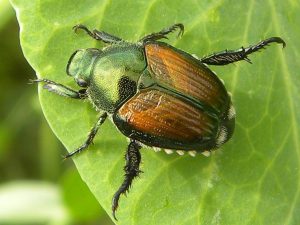Japanese Beetle
Pest Management Fact Sheet #5037
James F. Dill, Pest Management Specialist
Clay A. Kirby, Insect Diagnostician
Charles D. Armstrong, Cranberry Professional & Staff Entomologist
For information about UMaine Extension programs and resources, visit extension.umaine.edu.
Find more of our publications and books at extension.umaine.edu/publications/.
Description
The Japanese beetle, Popillia japonica, is a scarab beetle about 3/8“ long. The head and thorax are metallic green and the elytra (outer wing covers) are copper-colored. Adult feeding damage appears as lacy leaves. The Japanese beetle feeds on over 400 plants including rose, raspberry, bean, grape and blueberry. The adults are good fliers and can move from one area to another in large swarms. When threatened, adults will feign death, dropping from the plant and often flying away mid-drop.
- Adult Japanese Beetle
- White Grub
The larval stage is a C-shaped white grub similar in appearance to the grubs of the June beetle, rose chafer and European chafer. Japanese beetle grubs can be a major turf pest. A good indicator of a white grub infestation is skunks and crows digging up the lawn. The Japanese beetle white grub ‘treatment threshold’ is typically 8-10 grubs per square foot, at which point treatment is warranted.
Life Cycle
Japanese beetles usually emerge in the beginning of July and can be found from then through September. After mating, the females lay eggs in turf. The eggs hatch and the young white grubs feed from late July and early August until the first hard frosts of fall drive them deeper into the soil. After hibernating through the winter, the grubs migrate back up into the turf root zone to feed again in May and June. Around mid-June, the grubs pupate, eventually emerging as adults in one to three weeks.
Management
Managing adult Japanese beetles is challenging because of the large numbers that can occur throughout the summer. A combination of approaches is suggested. Consistent handpicking or vacuuming of the adults can help protect your plants from the ravages of this pest. A coffee can, about a third full of soapy water, can be used to collect the beetles. Although controversial, you may want to consider pheromone/bait traps as part of your management strategy.
Be sure to place traps at least 50 feet away from the plants you want to protect. Also, do not wait for the trap bags to completely fill before emptying them. Poorly maintained traps can be a liability instead of a help. In spite of some evidence that they may draw in more beetles than would normally be present, some gardeners have reported positive results with the traps. Protective barriers (e.g. spun-bonded material) can be used to protect susceptible plants during massive influxes of beetles. Foliage can be protected with sprays of pyrethrins, neem, Kaolin clay (Surround®), cyfluthrin/imidacloprid, malathion, or carbaryl (Sevin®). Repeat applications, if permitted by the label, are often necessary for protecting plants from this pest.
Japanese beetle white grub management efforts are most effective when control agents are in place when the white grubs are small and feeding in the turf root zone. In New England, beneficial nematodes (best application time: last three weeks of August) have been shown to be somewhat effective in managing white grubs. Milky spore has given spotty results and is not recommended.
White grub insecticides, such as chlorantraniliprole (GrubEx1®), most effective when applied mid-April through May, imidacloprid (Merit®) or halofenozide are also options to consider (best results obtained from a June or July application). Targeting the grub stage in hopes of relief from the adult beetles often leads to disappointment.
Be sure to read and follow label instructions on all management tools (traps, nematodes, and insecticides).
When Using Pesticides
ALWAYS FOLLOW LABEL DIRECTIONS!
Pest Management Unit
Cooperative Extension Diagnostic and Research Laboratory
17 Godfrey Drive, Orono, ME 04473
1.800.287.0279 (in Maine)
Information in this publication is provided purely for educational purposes. No responsibility is assumed for any problems associated with the use of products or services mentioned. No endorsement of products or companies is intended, nor is criticism of unnamed products or companies implied.
© 2016, 2018, 2020 | Reviewed and Revised: 2023
Call 800.287.0274 (in Maine), or 207.581.3188, for information on publications and program offerings from University of Maine Cooperative Extension, or visit extension.umaine.edu.
In complying with the letter and spirit of applicable laws and pursuing its own goals of diversity, the University of Maine System does not discriminate on the grounds of race, color, religion, sex, sexual orientation, transgender status, gender, gender identity or expression, ethnicity, national origin, citizenship status, familial status, ancestry, age, disability physical or mental, genetic information, or veterans or military status in employment, education, and all other programs and activities. The University provides reasonable accommodations to qualified individuals with disabilities upon request. The following person has been designated to handle inquiries regarding non-discrimination policies: Director of Equal Opportunity, 101 Boudreau Hall, University of Maine, Orono, ME 04469-5754, 207.581.1226, TTY 711 (Maine Relay System).



